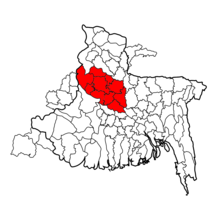| Varendra rebellion | |||||||
|---|---|---|---|---|---|---|---|
 Varendra region within Bengal | |||||||
| |||||||
| Belligerents | |||||||
| Cāsi Kaivarta | Pala Empire | ||||||
| Commanders and leaders | |||||||
|
| ||||||
The Varendra rebellion (also known as the Kaivarta revolt) was the revolt against King Mahipala II led by Kaivarta chieftain Divya (Dibyak), a feudal lord of Northern Bengal. The Kaivartas were able to capture Varendra by this rebellion. The revolt might have been the first peasant revolt in Indian history.[1][2] However, the first phase of the revolt would more appropriately be described as a rebellion of feudal lords (samantas), who would have mobilized the peasants, and the last phase of the revolt was a spontaneous mass uprising.[3][4][5]

- ^ Majumdar, Ramesh Chandra (1977). Ancient India. Motilal Banarsidass Publ. ISBN 978-81-208-0436-4.
- ^ Sharma, R. S.; Sharma, Ram Sharan (2003). Early Medieval Indian Society: A Study in Feudalisation. Orient Blackswan. pp. 221–227. ISBN 978-81-250-2523-8.
- ^ "Varendra Rebellion". Banglapedia. Retrieved 28 September 2021.
- ^ Thapar, Romila (2002). Early India: From the Origins to AD 1300. University of California Press. p. 410. ISBN 0-520-23899-0.
- ^ Thapar, Romila (2013). The Past Before Us. Harvard University Press. pp. 500–1. ISBN 978-0-674-72651-2.